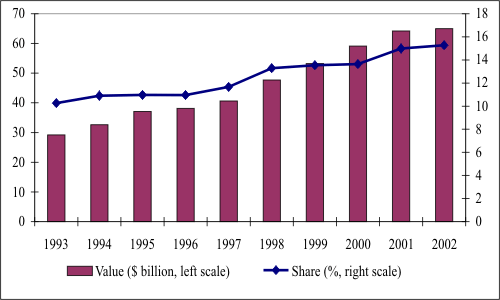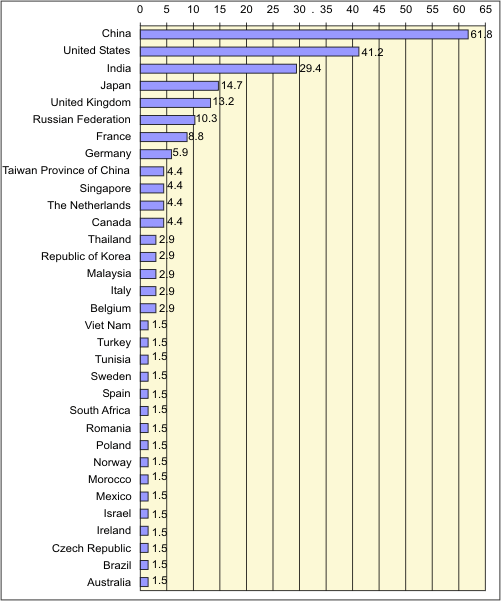| EMBARGO The contents of this press release and the related Report must not be quoted or summarized in the print, broadcast or electronic media before 29 September 2005, 17:00 GMT (1 PM New York, 19:00 Geneva, 22:30 Delhi, 02:00 - 30 September Tokyo) |
Transnational corporations are internationalizing more than their production activities these days - they are shifting an increasing proportion of their research and development to selected developing countries, says UNCTAD´s World Investment Report 2005: Transnational Corporations and the Internationalization of R&D (1) (WIR05), released today. The report, which includes UNCTAD´s first-ever survey on R&D by TNCs, finds that this internationalization of R&D is opening up new opportunities for investment and jobs, but that seizing these opportunities requires appropriate policies at both the national and international levels.
TNCs are dominant players in global R&D. In 2002, they accounted for about half of the US$ 677 billion spent on R&D worldwide, and for more than two thirds of all R&D in the business sector. The research and development spending of some large corporations is higher than that of many countries: Ford, Pfizer, DaimlerChrysler, Siemens, Toyota and General Motors each spent more than US$5 billion on R&D in 2003. Among developing economies, only China, the Republic of Korea, Taiwan Province of China and Brazil exceeded that amount.
Major businesses are shifting more of their R&D abroad, according to the UNCTAD report. German companies set up more foreign R&D units in the 1990s than in the preceding half-century; among major Swedish firms, the share of foreign R&D shot up from 22% to 43% between 1995 and 2003 alone. The R&D expenditures of foreign affiliates worldwide climbed from an estimated US$ 30 billion in 1993 to US$ 67 billion in 2002 (fig. 1). But this internationalization is not new; what is new, the report finds, is that more R&D is going to developing countries. Developing Asia is the preferred destination; firms based in the US, for example, carried out 10% of their overseas R&D in such countries in 2002, up from 3% in 1994, and more than half the world´s top R&D spenders are already conducting research and development in China, India or Singapore.
| "Firms now view parts of the developing world as key sources not only of cheap labour, but also of growth, skills and even new technologies", says UN Secretary-General Kofi Annan in the preface to the report. |
The trend is accelerating. In China, the number of foreign R&D units rose from zero to 700 over the course of a decade. In India, global pharmaceutical companies are engaged in increasingly numerous clinical research activities, while General Electric employs 2,400 people in R&D on products ranging from aircraft engines to consumer durables and medical equipment. Thailand was selected for Toyota´s fourth overseas R&D centre, and more than 100 TNCs have set up research labs in Singapore.
In the past, major corporations used R&D in developing countries largely as a way of adapting products and processes to local markets. But now the trend is increasingly towards technology development for regional or global markets, and towards applied research. For example, from practically nothing in the mid-1990s, the share of South-East and East Asia in global semiconductor design reached almost 30% in 2002.
"Firms now view parts of the developing world as key sources not only of cheap labour, but also of growth, skills and even new technologies", says UN Secretary-General Kofi Annan in the preface to the report.
The expansion of R&D into selected developing countries, says UNCTAD, is a reaction to increased competition, which forces firms to innovate more at lower cost. TNCs are especially attracted to host countries that have the appealing combination of low wages and large pools of skilled workers. The historical near-monopoly of developed countries on scientists and engineers is diminishing. In 2000/01, for example, China, India and Russia together accounted for a third of all tertiary technical students in the world.
The growing trend towards R&D internationalization is likely continue, the UNCTAD report predicts. Underlying factors will provide compelling reasons for TNCs to seek out new locations for R&D activities. And as local enterprises and institutions in developing countries take part in those activities, they will progressively enhance their abilities and be in a better position to attract more business.
As many as 69% of firms responding to UNCTAD´s new survey expect the share of foreign R&D in their total R&D expenditures to increase; only 2% predict the opposite. China is the most frequently cited location for future R&D expansion, followed by the US and India (fig. 2). Other developing economies mentioned as potential candidates for R&D are the Republic of Korea, Singapore, Taiwan Province of China, Thailand and Viet Nam. Few respondents indicated any plans to expand their R&D into Latin America or Africa. Among members of the Commonwealth of Independent States, Russia is by far the preferred destination for R&D work.
Foreign direct investment in research and development can help countries strengthen their innovation capabilities, enabling them to perform more demanding functions, handle more advanced equipment and make more complex products, the report suggests. But these benefits do not accrue automatically. The requirements for entering the game are demanding, and most developing countries have not taken part in it. Whether developing countries host R&D activities by TNCs, and benefit from linking up with their global R&D networks depends on their technological capabilities. This, in turn, is dependent on the quality of human resources and institutions (including organizations and rules governing innovation activities) and the capabilities of domestic firms.
There are huge gaps among developing countries in these areas, as illustrated in the UNCTAD Innovation Capability Index, a new feature of the report this year. Bridging them is a major development challenge in itself. It is also essential for ensuring that R&D internationalization benefits more of the world, the report contends.
Policy coherence crucial
Policy lessons can be learned from those developing countries now emerging as important nodes for R&D work. According to the report, active and coherent government involvement, especially in the fields of innovation, education and investment policy, is particularly important. As part of a long-term strategy, these particular countries have sought to attract technology, skills and capital from abroad; have invested strategically in human resources; and have established science parks, public R&D labs and incubators. They have also used targeted FDI policies and set up systems to protect intellectual property.
For developing countries that currently have weak innovation capabilities, an influx of R&D from TNCs cannot be expected in the short term, UNCTAD warns. Those countries should now start to consider how to begin a process through which economic and technological upgrading can be promoted. The task is daunting, and many countries will need assistance from the international community, especially in human resource development. Such support could be used to strengthen local educational infrastructures and make educational opportunities in developed countries available to citizens from developing countries.
| The World Investment Report and its database are available online at www.unctad.org/wir and www.unctad.org/fdistatistics . A complete set of UNCTAD´s major publications on FDI and TNCs - the UNCTAD/UNCTC Digital Library - can be found at http://unctc.unctad.org . |
ANNEX
Tables and figures
Figure 1: R&D expenditure by foreign affiliates, based on a sample of 30 economies, values and share in business R&D, 1993-2002 - (Billions of dollars and per cent)
Source: UNCTAD, World Investment Report 2005
Figure 2: Most attractive prospective R&D locations, 2005-2009 - (Per cent of respondents mentioning the location)
Source: UNCTAD, World Investment Report 2005


